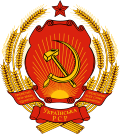You can help expand this article with text translated from the corresponding article in Ukrainian. (November 2022)Click [show] for important translation instructions.
|
17 March 1991 | ||||||||||||||||||||||
Do you agree that Ukraine should be part of a Union of Soviet Sovereign States on the basis on the Declaration of State Sovereignty of Ukraine? | ||||||||||||||||||||||
| Results | ||||||||||||||||||||||
|---|---|---|---|---|---|---|---|---|---|---|---|---|---|---|---|---|---|---|---|---|---|---|
| ||||||||||||||||||||||


 |
|---|
A sovereignty referendum was held in the Ukrainian SSR on 17 March 1991 as part of a USSR-wide referendum. Voters were asked two questions on reforming the Union of Soviet Socialist Republics into the Union of Sovereign States. Most voters supported the proposal, although in the pro-independence oblasts of Ivano-Frankivsk, Lviv and Ternopil, voters opted for independence as part of an additional question.
Contents
The referendum followed the Declaration of State Sovereignty by the republic's parliament on 16 July 1990 as sovereign republic within the Soviet Union in line with the results. [1]
In August 1991, with the August Coup preventing the New Union Treaty from being adopted by the Soviet Union, a withdrawal from the USSR was proposed leading to a declaration of independence being drafted. The overwhelming majority of voters would back the idea in a independence referendum in December. [2]
